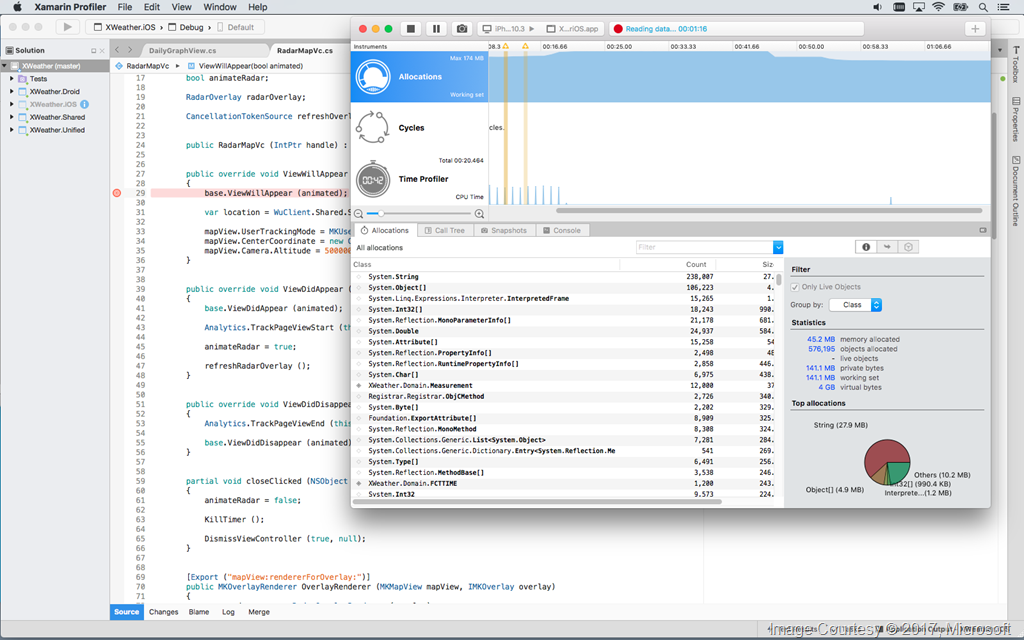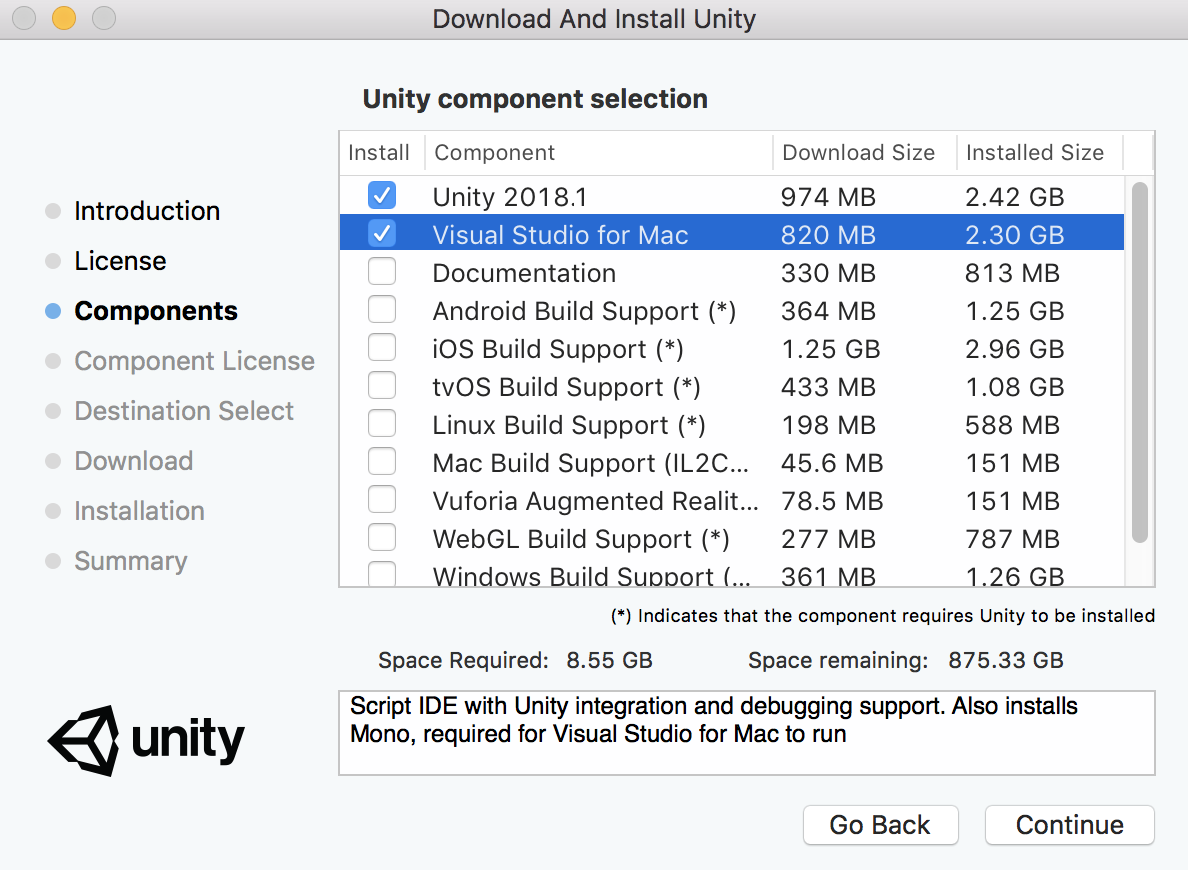Visual Studio Mac Download
How do I install a Visual Studio for Mac preview build? How can I get the Visual Studio for Mac installation logs? Licensing and Purchase (3) The Community edition expired, do I have to buy a license? How do I purchase Visual Studio Professional for Mac or Visual Studio Enterprise for Mac? Can I use my existing Visual Studio license on a Mac. Oct 14, 2019 Visual Studio for Mac now supports Source Link. This allows you to debug into source code from NuGet packages that ship.PDBs with links to source files. Visual Studio for Mac will detect that source files are available and offer to download the.
Visual Studio 2019 for Mac documentation Get started with Visual Studio for Mac. Install and learn about the Visual Studio for Mac Integrated Development Environment (IDE). MacinCloud supports the latest Microsoft Visual Studio for Mac with Xamarin components. GET STARTED RIGHT AWAY Managed Server Plan and Dedicated Build Server Plan have Microsoft Visual Studio Community and Xamarin Community for Mac configured.; SEE THE LATEST VERSIONS IN ACTION Login and access the latest development tools. Install Visual Studio for Mac behind a firewall or proxy server. To install Visual Studio for Mac behind a firewall, certain endpoints must be made accessible in order to allow downloads of the required tools and updates for your software.
-->Get started with Visual Studio for Mac
Install and learn about the Visual Studio for Mac Integrated Development Environment (IDE).
What apps can I build?
With Visual Studio for Mac you can build websites with ASP.NET Core and apps using .NET Core, games with Unity, and mobile apps for Android and iOS using Xamarin. Azure can be incorporated into all your apps.
What languages can I use?

With Visual Studio for Mac you can write in C#, F#, Razor, HTML5, CSS, Javascript and Typescript, XAML, and XML.
Write code with Visual Studio for Mac
Learn more about using Visual Studio to write, compile, debug, and store your code.
I need more help
Links to other useful content
-->Caution
The preview TFVC extension for Visual Studio for Mac is no longer supported in Visual Studio 2019 for Mac.
Alternative Version Control options in Visual Studio for Mac
For the best version control experience on macOS, we recommend using Git instead of Team Foundation Version Control (TFVC).
Git is supported in Visual Studio for Mac and is the default option for repositories hosted in Team Foundation Server (TFS)/Azure DevOps. To learn more about using Git with TFS/Azure DevOps, see the Setting up a Git Repository guide.
Unsupported workarounds for TFVC
While Visual Studio for Mac doesn't officially support TFVC, the rest of this guide provides some workarounds to work with TFVC on macOS. If you're using TFVC for version control today, here are some solutions you can use to access your source code hosted in TFVC:
- Option 1. Use Visual Studio Code and the Azure Repos extension, for a graphical UI
- Option 2. Connect to your repo using the Team Explorer Everywhere Command Line Client (TEE-CLC)

Option 1. Use Visual Studio Code and the Azure Repos extension
If you like to work with a graphical interface to manage your files in version control, then the Azure Repos extension for Visual Studio Code provides a supported solution from Microsoft. To get started, download Visual Studio Code and then learn how to configure the Azure Repos extension.
Option 2. Connecting using the Team Explorer Everywhere Command Line Client
Important
As per the Team Explorer Everywhere README, this project is no longer being maintained.
If you're comfortable using the macOS Terminal, then the Team Explorer Everywhere Command Line Client (TEE-CLC) provides a supported way to connect to your source in TFVC.
You can follow the steps below to set up your connection to TFVC and commit changes.
Setting up the TEE-CLC
There are two ways to get setup with the TEE-CLC.
- Use Homebrew to install the client, or
- Download and manually install the client
The easiest solution is using HomeBrew, which is a package manager for macOS. To install using this method:
 It is commonly used on Mac OSX system, just like ISO file on Windows. Most of Mac OSX software are packed into a dmg file, which can be mounted as a volume within the OSX Finder, thus you can install the software without using a physical disc. AnyBurn can extract dmg file, convert dmg file to iso format, or burn dmg file to a new disc directly. DMG file is a disk image format created by Apple and massive used on Mac based computers. It can be converted to the ISO format using several different ways, but to burn it on to a DVD or CD to make it bootable is probably the best approach if you're only working with Mac systems. However, we've also covered how to burn a DMG file to a disk on Windows systems, in case that's what you have to. The DMG files normally contain program installation files for Apple system and applications, but they can also be used to hold compressed files. With PowerISO, you can manipulate dmg files on Windows PC. PowerISO can burn dmg file directly to a CD / DVD disc. This guide will let you know how to open & burn.dmg files in Windows OS. We will be using Transmac Software to install a software which have a.dmg extension. Jan 20, 2018 Windows 10 natively support mounting or burning files with ISO and IMG extensions. Hence, IMG is just enough for the purpose if burning DMG to DVD in Windows PC is the sole requirement. To do this, right-click on the IMG file and pick the option “bun to DVD disc,” and follow the instructions.
It is commonly used on Mac OSX system, just like ISO file on Windows. Most of Mac OSX software are packed into a dmg file, which can be mounted as a volume within the OSX Finder, thus you can install the software without using a physical disc. AnyBurn can extract dmg file, convert dmg file to iso format, or burn dmg file to a new disc directly. DMG file is a disk image format created by Apple and massive used on Mac based computers. It can be converted to the ISO format using several different ways, but to burn it on to a DVD or CD to make it bootable is probably the best approach if you're only working with Mac systems. However, we've also covered how to burn a DMG file to a disk on Windows systems, in case that's what you have to. The DMG files normally contain program installation files for Apple system and applications, but they can also be used to hold compressed files. With PowerISO, you can manipulate dmg files on Windows PC. PowerISO can burn dmg file directly to a CD / DVD disc. This guide will let you know how to open & burn.dmg files in Windows OS. We will be using Transmac Software to install a software which have a.dmg extension. Jan 20, 2018 Windows 10 natively support mounting or burning files with ISO and IMG extensions. Hence, IMG is just enough for the purpose if burning DMG to DVD in Windows PC is the sole requirement. To do this, right-click on the IMG file and pick the option “bun to DVD disc,” and follow the instructions.
- Launch the macOS Terminal application.
- Install Homebrew using the Terminal and the instructions on the Homebrew home page.
- Once Homebrew is installed, run the following command from your Terminal:
brew install tee-clc
To setup the TEE-CLC manually:
- Download the latest version of the tee-clc from the releases page of the Team Explorer Everywhere GitHub repo (e.g. tee-clc-14.134.0.zip at the time of this writing).
- Extract the content of the .zip to a folder on disk.
- Open the macOS Terminal app and use the
cdcommand to switch to the folder you used in the previous step. - From within the folder, run the command
./tfto test that the command line client can run, you may be prompted to install Java or other dependencies.
Once the TEE-CLC is installed, you can run the command tf eula to view and accept the license agreement for the client.
Finally, to authenticate with your TFS/Azure DevOps environment, you'll need to create a personal access token on the server. Learn more about authenticating with personal access tokens. When creating a personal access token to use with TFVC, be sure to provide Full Access when configuring the token.
Using the TEE-CLC to connect to your repo
Visual Studio Xamarin Mac Download
To connect to your source code, you first need to create a workspace using the tf workspace command. For example, the following commands connect to an Organization in Azure DevOps Services called 'MyOrganization':
The TF_AUTO_SAVE_CREDENTIALS environment setting is used to save your credentials so you aren't prompted to enter them multiple times. When prompted for a user name, use the personal access token you created in the previous section and use a blank password.
To create a mapping of your source files to a local folder, you'll use the tf workfold command. The following example will map a folder named 'WebApp.Services' from the 'MyRepository' TFVC project and set it up to be copied into the local ~/Projects/ folder (i.e. a 'Projects' folder in the current users's home folder).
Finally, you use the following command to get the source files from the server and copy them locally:
Committing changes using the TEE-CLC
After you've made changes to your files in Visual Studio for Mac, you can switch back to the Terminal to check in your edits. The tf add command is used to add files to the list of pending changes to be checked-in and the tf checkin command performs the actual check-in to the server. The checkin command includes parameters to add a comment or associate a related work item. In the following code snippet, all files in a WebApp.Services folder are added, recursively, to the checkin. Then, the code is checked in with a comment and associated with a work item with the ID '42'.
Visual Studio 2015 Mac Download
To learn more about the commands mentioned here, or others, you can use the following command from the Terminal:
tf help